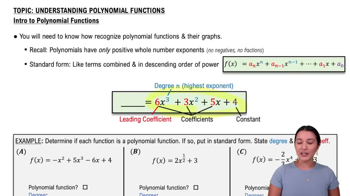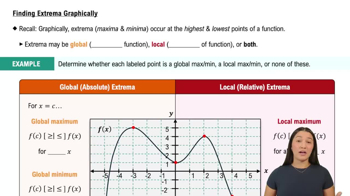Table of contents
- 0. Functions7h 52m
- Introduction to Functions16m
- Piecewise Functions10m
- Properties of Functions9m
- Common Functions1h 8m
- Transformations5m
- Combining Functions27m
- Exponent rules32m
- Exponential Functions28m
- Logarithmic Functions24m
- Properties of Logarithms34m
- Exponential & Logarithmic Equations35m
- Introduction to Trigonometric Functions38m
- Graphs of Trigonometric Functions44m
- Trigonometric Identities47m
- Inverse Trigonometric Functions48m
- 1. Limits and Continuity2h 2m
- 2. Intro to Derivatives1h 33m
- 3. Techniques of Differentiation3h 18m
- 4. Applications of Derivatives2h 38m
- 5. Graphical Applications of Derivatives6h 2m
- 6. Derivatives of Inverse, Exponential, & Logarithmic Functions2h 37m
- 7. Antiderivatives & Indefinite Integrals1h 26m
- 8. Definite Integrals4h 44m
- 9. Graphical Applications of Integrals2h 27m
- 10. Physics Applications of Integrals 2h 22m
5. Graphical Applications of Derivatives
Intro to Extrema
Problem 4.1.29
Textbook Question
Locating critical points Find the critical points of the following functions. Assume a is a nonzero constant.
ƒ(x) = x³ -4a²x
 Verified step by step guidance
Verified step by step guidance1
To find the critical points of the function \( f(x) = x^3 - 4a^2x \), we first need to find its derivative. The derivative, \( f'(x) \), will help us identify where the slope of the tangent to the curve is zero or undefined.
Differentiate the function \( f(x) = x^3 - 4a^2x \) with respect to \( x \). Using the power rule, the derivative is \( f'(x) = 3x^2 - 4a^2 \).
Set the derivative \( f'(x) = 3x^2 - 4a^2 \) equal to zero to find the critical points. This gives the equation \( 3x^2 - 4a^2 = 0 \).
Solve the equation \( 3x^2 - 4a^2 = 0 \) for \( x \). This can be done by adding \( 4a^2 \) to both sides and then dividing by 3, resulting in \( x^2 = \frac{4a^2}{3} \).
Take the square root of both sides to solve for \( x \). Remember to consider both the positive and negative roots, so \( x = \pm \sqrt{\frac{4a^2}{3}} \). These are the critical points of the function.
 Verified video answer for a similar problem:
Verified video answer for a similar problem:This video solution was recommended by our tutors as helpful for the problem above
Video duration:
2mPlay a video:
Was this helpful?
Key Concepts
Here are the essential concepts you must grasp in order to answer the question correctly.
Critical Points
Critical points of a function occur where its derivative is either zero or undefined. These points are essential for identifying local maxima, minima, and points of inflection. To find critical points, one typically takes the derivative of the function and solves for the values of x that satisfy the condition.
Recommended video:

Critical Points
Derivative
The derivative of a function measures the rate at which the function's value changes as its input changes. It is a fundamental concept in calculus, representing the slope of the tangent line to the curve at any given point. For polynomial functions, the derivative can be calculated using power rules, which simplify the process of finding critical points.
Recommended video:

Derivatives
Polynomial Functions
Polynomial functions are expressions that involve variables raised to whole number powers, combined using addition, subtraction, and multiplication. The function given, ƒ(x) = x³ - 4a²x, is a cubic polynomial. Understanding the behavior of polynomial functions, including their derivatives, is crucial for analyzing their critical points and overall shape.
Recommended video:

Introduction to Polynomial Functions

 5:58m
5:58mWatch next
Master Finding Extrema Graphically with a bite sized video explanation from Callie
Start learning





